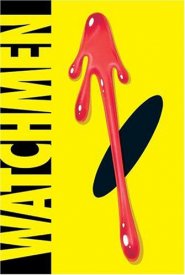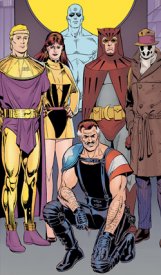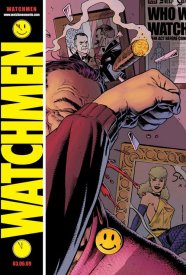DeathDealer
kickbox

PLOT:
The story is set in an alternate 1985 where superheroes exist, Richard Nixon is still president, and tensions between the United States and the Soviet Union are at an all-time high. The vigilante Rorschach is investigating the murder of a former hero, the Comedian, and uncovers a plot to discredit and murder various heroes. Rorschach discovers a far wider-ranging conspiracy involving his colleagues' past which could completely change the course of history.
The Superheroes:
Dan Dreiberg
Born in 1945, Daniel Dreiberg relied more upon technical wizardry and tools than toughness, which set him apart from his fellow costumed adventurers. Still, he has demonstrated more than adequate skills when defending himself. All of his gadgets and costumes are based on an owl theme. He uses an owl-shaped flying vehicle nicknamed the "Owlship" or "Archie" (Archimedes, after Merlin's pet owl), equipped with a variety of offensive and defensive devices, such as flamethrowers and "screechers" -devices capable of producing a sharp screech-like sound.
Rorschach
Wearing the inkblot-like mask he considers his true face, Rorschach has continued his one-man battle against crime long after superheroes have become both detested and illegal. Rorschach’s actions and journal writings display a belief in moral absolutism and moral objectivism, where good and evil are clearly defined and evil must be violently punished. He has alienated himself from the rest of society to achieve these aims. Politically, he is an anti-communist, anti-liberal, reactionary, and strong nationalist.
Laurie Juspeczyk
Sally pushed her daughter into the "family business of crimefighting." Laurie Juspeczyk never held much interest in becoming her mother's successor, but went along with Sally's wishes anyway. Growing up, the brunette Laurie knew Laurence Schexnayder was not her real father, and she always believed, incorrectly, that her real father was Hooded Justice. Laurie Juspeczyk is a liberal-thinking, modern woman. She is vocal in her feminist and humanitarian concerns, and is quite a conditioned fighter, and at the start of the story is shown to have a strained relationship with her mother. Driven by the memories of her own experience, Sally tried to keep Laurie from knowing some of the harsher realities of the crimefighting life. For example, she didn't allow her to read Hollis Mason (Nite-Owl I)'s autobiography Under the Hood (which included mention of the Comedian's sexual assault on Sally, something Laurie knew nothing of). Sally acted like an agent for her daughter, picking out her costume, and chauffeering her to "Crimebusters" meetings. After one of these meetings, Laurie met the Comedian outside, who commented and complimented her for being the spitting image of her mother, but their conversation was broken up quickly by an angry Sally Jupiter. Laurie noted that the Comedian looked sad as he watched them drive away, and felt sorry for him. During the car ride home, Sally told her daughter of her history with the Comedian, but did not tell her that the Comedian was her father. Disgusted and deeply saddened for her mother's pain, Laurie never forgave the Comedian for his actions, though it seems that as time passed, and in a complicated way, Sally was able to come to terms with it, even to the point that she was willing to defend the Comedian from Laurie's derogatory remarks after he was murdered. Shortly after the meeting of the Crimebusters, Laurie met and became involved with Doctor Manhattan (at the age of 16), something her mother did not approve of, likening Laurie's relationship with Manhattan to being the equivalent of sleeping with an H-bomb. Drawn to him from the moment she first saw him, Laurie worked with Doctor Manhattan in some of his various domestic assignments, including the suppression of riots during the police strike of 1977. Never exactly happy being a vigilante and not happy with the government taking advantage with her relationship with the superhuman Manhattan, Laurie was more than pleased to quit being a superhero when the Keene Act of 1977 forced all but government-sponsored superheroes to retire.
Dr. Manhattan
The following months see a series of strange events and apparitions at the research base, leading residents to speculate the area is now haunted. It becomes plain that Jon has been reforming himself during this time, the progression being indicated by a series of partial bodily reappearances: first as a disembodied nervous system, including the brain and eyes; then as a circulatory system (November 10); then a partially muscled skeleton (November 14). Each time, the appearance only lasts for a few seconds. Jon fully reappears on November 22 as a tall, hairless, naked, blue-skinned man. After his transformation, Jon begins to experience time in a non-linear, "quantum" fashion, and it is implied that he is aware of and experiencing all the moments of his life simultaneously. Jon is not omniscient; he remains reliant on his intellect and sensory experience to reach conclusions, but his range of sensory data has been abruptly extended, in proportion to the lessening of his emotional capacities. This often leads him to arrive at conclusions greatly different from those available to normal humans. His already weak will (marked by his apparent submission to his father's career plans, whatever they might be) becomes sublimated further during this time. He increasingly has difficulty acting in what those around him consider the present moment, leading to many accusations and even the public perception that he is emotionless and uninterested in human affairs. For instance, he does nothing to prevent the assassination of President John F. Kennedy, even though he is aware it is going to happen as he meets the President. However, during the course of Watchmen he displays powerful emotion several times. His apparent lack of sentiment is more a matter of radically altered priorities, owing to a colossal, unbridgeable gap of perception between Jon and the rest of humanity. He subscribes to a deterministic view of events (at one point remarking "We're all puppets, Laurie. I'm just a puppet who can see the strings."). Throughout most of Watchmen, Doctor Manhattan appears to exert an effort of choice, and his actions often seemed governed by a rigidly utilitarian code of ethics in which the correct course of action must be the one that benefits the most. In some sense, unlimited power has come at the cost of the total absence of responsibility, and his growing detachment, if not apathy, is juxtaposed with his apparent ability to do anything. During the period in which Doctor Manhattan is a crime-fighter (at the behest of the government), he states that the morality of such activities escapes him. From his radically altered perspective, almost all human concerns appear pointless and without obvious merit.
Ozymandias
Adrian Veidt was born in 1939, the son of rich immigrant parents. After his parents' deaths, he inherited their substantial fortune at age 17, but chose to give it all to charity and embark on a vision quest, following the route of his childhood idol Alexander the Great.
Returning to America Veidt named himself Ozymandias and became a costumed vigilante, earning a reputation as "the smartest man on the planet."
In 1975, two years before vigilante crimefighters (superheroes) were banned by the "Keene Act," Veidt retired from superheroism, marketing his image for money. This helped bankroll Veidt's scheme of creating a catastrophic event to deceive the world into uniting against a common enemy. Upon completion of his project, Veidt arranged the murder of all of his accomplices and the exile of the presumably invincible Dr. Manhattan.
The Comedian
The Comedian is a cigar-chomping, gun-toting vigilante-turned-paramilitary agent. During some of the series' most intense moments, he has shown himself to be a nihilist with little regard for morality or human life.
Nite Owl
At the age of 12 his father left the family farm in Montana and moved to New York City, working at Moe Vernon's Auto Repairs. Starting out as a New York City policeman in 1938, he was inspired by Action Comics' Superman and the real life exploits of Hooded Justice to take up the life of a vigilante. He was nicknamed Nite Owl for spending his evenings working out in the Police Gymnasiums as much as possible and going to bed at 9:00pm to rise for a 5:00am work out before donning his badge and uniform. His costume was designed to free his arms and legs while protecting his chest, abdomen and head with a tough leather tunic. With the tunic hiding his hair, a domino mask concealed his identity. He became a member of the Minutemen, a "masked adventurer" league in mid-1939. Mason was an "old school" crimefighter, a real "Boy Scout" in the eyes of Captain Metropolis. He stopped colorful criminals like the Screaming Skull and went on to fight supposed Axis operatives including Captain Axis during World War II. He retired in May, 1962 to open an auto business and write his memoir of his crime-fighting exploits, Under the Hood. By reading Under the Hood, Laurie Juspeczyk later learned of the Comedian's attempted rape of her mother Silk Spectre.
Silk Spectre
Silk Spectre was former frizzy haired, redhead waitress and burlesque dancer Sally Jupiter (her real last name was Juspeczyk, which she changed to hide her Polish ancestry), who entered action sometime around 1938 when she was only 18 years old. In her time, she was a sex symbol by whom criminals didn't mind getting caught. She was an action heroine version of a pin-up girl and, even in her old age, she seemed proud of her sex symbol status, apparently enjoying male attention as indicated by her career as a dancer and her reaction to learning of a Tijuana bible that was based on her, much to her daughter's disapproval.
Moloch the Mystic
A crime boss from the 1940s through the 1960s, he ran an underground vice den and constructed a solar mirror weapon as part of his nefarious schemes. Over the course of his criminal career, he clashed with both Nite Owls, Ozymandias, and Doctor Manhattan. Eventually captured, he spent the 1970s in prison, where he converted to Christianity and gave up his life of crime. At some point during that time, he worked for a company run by Adrian Veidt, Dimensional Developments, where he was secretly bombarded with radiation to induce cancer as part of Veidt's scheme to drive Dr. Manhattan off the planet as part of his larger plan. Following Moloch's release, he lived alone in New York City, until his murder in 1985 as part of Ozymandias' plot.
Mothman
Lewis was investigated by HUAC, and had difficulty clearing his name due to several left-wing friends. The pressure from these investigations is considered to have precipitated his alcoholism and the subsequent mental health problems that eventually consigned him to a sanatorium. He is not a main focus of the storyline, but appears in flashbacks, at one point reduced in his later years to fragile sanity, unnerving the second Silk Spectre. He is regarded fondly by most of the Minutemen, and the first Nite Owl sends the second to visit him, uncostumed, on his behalf.
Dollar Bill
Dollar Bill was originally a star college athlete from Kansas who was actually employed as an in-house super-hero by one of the major, but unnamed, national banks. While attempting to stop a raid upon one of his employer's banks, his cloak became entangled in the bank's revolving door and he was shot dead at point blank range before he could free it. In "Under the Hood", Hollis Mason's tell-all book, he described Dollar Bill as an honest, friendly young man, and rues the stupidity of capes because of this. Interestingly enough, Dollar Bill's clear commercial motivations (public identity, hired by a bank) are never commented on by his peers or the subsequent generation of vigilantes who all seem to regard him as a worthy hero - even Rorschach, who condemns Ozymandias for his commercialization, laments Dollar Bill's untimely death.


There is also a film going to be released based off of the graphic book novel, set for theaters worldwide on March 6, 2009.
CAST:
Patrick Wilson as Daniel Dreiberg
Jackie Earle Haley as Rorschach
Malin Akerman as Laurie Juspeczyk
Billy Crudup as Dr. Manhattan
Matthew Goode as Ozymandias
Jeffrey Dean Morgan as The Comedian
Stephen McHattie as Nite Owl
Carla Gugino as Silk Spectre
Matt Frewer as Moloch the Mystic
Niall Matter as Mothman
Dan Payne as Dollar Bill
Trailer:
Watchmen Trailer - Trailer Addict
Comic-Con Trailer:
Watchmen Comic Con Trailer - Trailer Addict
Movie Poster:




